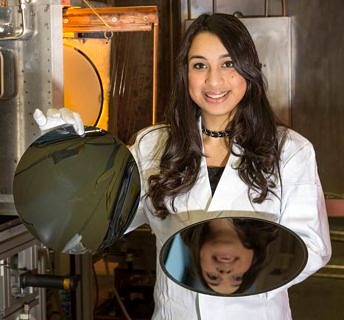The world’s largest diamond foil
FAU researchers grow a versatile diamond foil in a test reactor
FAU material researchers have come a step closer to their goal of providing large diamond foils for practical applications. In a test reactor, they have succeeded in producing the world’s largest diamond foil with a diameter of 28 centimetres. Diamond foils can be used as ultimate wear protection in industrial applications and for research into thermoelectric power generation – an emerging market.*
Diamonds are not only considered valuable, but also virtually indestructible. They are one of the hardest natural materials in our universe. Consequently it is not surprising that producing diamond foils has become a key area in materials science research, particularly as these layers feature extreme hardness and wear resistance, exceptional chemical inertness and maximum thermal conductivity. Unfortunately, coating substrates directly with crystalline diamond is only possible on a limited range of materials. The research group ‘Ultra Hard Coatings’ at FAU’s Chair of Materials Science and Technology of Metals has developed a process of growing diamond coatings on silicon substrates which can be used on materials which are not suitable for direct coating. They have now succeeded in producing the world’s largest diamond foil with a diameter of 28 centimetres. ‘By scaling up the manufacturing process, we have demonstrated that we can produce diamond foils in future as a semi-finished product for industry even in large dimensions,’ explains Dr. Stefan Rosiwal, head of the Ultra Hard Coatings research group at the Chair of Materials Science and Technology of Metals. ‘In these diamond layers, we can adjust the diamond grain size, the electrical conductivity and thermal conductivity by varying the manufacturing parameters by many orders of magnitude.’
The procedure
Over several days, the diamond foils are produced in a test reactor in which a 40-micrometre thick diamond layer – approximately the thickness of a human hair – is grown on a silicon disc with a diameter of 30 centimetres. The diamond foils are produced in a low-pressure atmosphere of hydrogen and two percent methane under wires which are heated to 2000 degrees Celsius. After the coating process, a short pulse laser is used to introduce a circular fracture site with a diameter of 28.5 centimetres into the diamond surface. This makes it possible to separate the deposited layer as a very smooth diamond foil from the silicon substrate.
Potential applications
This procedure has opened up a whole new range of other possible applications. Virtually any substrate material can be coated with diamond film by means of a suitable joining technique. The extremely hard and smooth diamond foils can, for example, protect component surfaces against wear and tear. Research has already shown that diamond foils can give 100% protection for water turbines which are exposed to erosion from sand. Now that researchers have demonstrated diamond foil manufacturing processes successfully on a larger scale, this opens up opportunities for coating industrial components directly in a more cost effective way. Such industrial components include wear-resistant layers for mechanical seals in pumps as well as the production of stable diamond electrodes for highly efficient water purification and disinfection systems. These innovative diamond electrode systems are used for washing and disinfecting oranges after harvesting in southern Europe, removing putrefying bacteria from the surface of the fruit and saving up to 80% water. In the future, the technology could be used on container ships or sewage treatment plants. Diamond electrodes may even help in washing machines by keeping clothes clean and fresh at significantly lower temperatures.
*The findings were published under the titles ‘Mechanical properties of micro- and nanocrystalline diamond foils’ and ‘Thermoelectric transport properties of boron-doped nanocrystalline diamond foils’ in the renowned scientific journals ‘Philosophical Transactions A’ doi:10.1098/rsta.2014.0136 and ‘Carbon’ doi:10.1016/j.carbon.2014.10.002.
More information
PD Dr.-Ing. habil. Stefan M. Rosiwal
Phone: +49 9131 8527517
stefan.rosiwal@fau.de
